Lock On: Modern Air Combat Hands-On Preview
We go hands-on with Eagle Dynamics' upcoming air-combat simulator.
Release date delays are not uncommon in the computer gaming business, yet few titles can lay claim to nearly two years of setbacks. Nevertheless, such is the case with Ubisoft's air combat simulator Lock On: Modern Air Combat. Originally planned for late 2001, Lock On will finally ship on November 18 of 2003. And that's not a moment too soon for hardcore pilots.
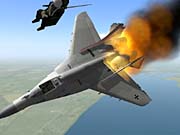
Clearly, Lock On is an ambitious project. Ubisoft and Russian-based developer Eagle Dynamics have taken on a wide variety of issues with the game, not the least of which is the purported death of the genre. The cost of producing a quality air combat sim, it has been said, is too steep given its limited appeal. Furthermore, there is a question as to whether Eagle can successfully merge the best elements of a "survey" and "study" sim in one neat package. Can a game that offers six unique aircraft really do an authoritative and authentic job of each? And lastly, can a game that promises ultrarealism also deliver on its guarantee of scalability? Will a bright-eyed rookie feel just as comfortable as a studied veteran?
For the definitive answers to these and other questions, we'll all have to wait patiently until Lock On goes gold in November. In the meantime, we had a chance to take a late prerelease version for a few test flights. While it wasn't finalized and felt a bit rough around the edges, the version we played suggests that Lock On may well be just the kick start this genre needs, delivering on most of the above conditions and providing a highly authentic, highly tweakable air combat experience inside one of the prettiest environments to ever grace any combat or civilian flight sim.
When you first launch the game, you'll see that Eagle has constructed a clinical menu system that's more dapper than it is electrifying. It's also extremely efficient. Selections are made via Windows-type buttons and drop-down menus. There are no slick animations to waste your time or slow the proceedings. If you want to hit the skies for a quick jaunt, you'll merely click the "Fly" button beneath your chosen aircraft. No further input is required. If you want some degree of control over what you'll encounter on a quick flight, choose the "fast battle planner" and be whisked away to another set of screens where you can select your airborne and nonairborne adversaries, choose your flight paths, and decide upon options such as weather, terrain, altitude, fuel load, and so on. There are numerous other game modes and options as well, which we'll get into a bit later.
Like the renowned Flanker series that gave rise to it, Lock On focuses on late-model jets embroiled in air-to-air, air-to-ground, and air-to-sea conflicts over the southern Ukraine and northern Black Sea region. The game will sport an incredible number of physical items, including nearly 200,000 buildings, 21 cities, 1,700 towns and villages (certainly nothing approaching a real city), 500 bridges, 18 airfields, eight naval bases, and a startling half-billion trees. Then, of course, there are the aircraft. Eagle has fashioned nearly 50 unique nonflyable jets, helicopters, and prop-driven warbirds for Lock On and another eight that are completely and fully flyable. Granted, three of these are virtually identical machines (the German MiG-29A and Russian MiG-29A and MiG-29C), yet the other five (Su-25, Su-27 Flanker B, Su-33 Flanker D, F-15C Eagle, and A-10A Thunderbolt "Warthog") are very distinctive indeed.
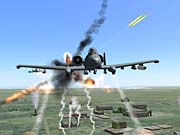
So distinctive, in fact, that Eagle has seen fit to offer individual tutorials. Twenty-nine tutorials will appear in the final product, divided between basic control, hyperadvanced Top Gun stuff, and specific training for each flyable aircraft and even several of their unique weapons. One of the F-15's training runs teaches you specifically about pulse Doppler radar. One of the Su-25's lessons spells out the nuances of its R-60 Aphid air-to-air missile. This is just one of several measures Eagle has taken to help familiarize newcomers and further the knowledge and abilities of pros.
As advertised, the game will indeed be scalable. Lock On will offer four generic levels of difficulty, each of which can then be fully customized. Unlimited weapons, unlimited fuel, easy flight models, immortality, enhanced (or reduced) missile effectiveness, auto lock-ons, easy radar, object labels--these are just some of the many variables.
However, no matter how much simplification you dial in or how many tutorials you take, it doesn't seem like Lock On will make it truly easy for the first-time pilot. For starters, the control set is positively stupefying, comprising six full pages of single-spaced instructions when printed on standard letter-size paper. Furthermore, certain commands apply only to one model of aircraft. Accordingly, it will take several hours for those unfamiliar with air combat sims in general to properly orient themselves.
Fasten Your Seat Belts
And as for those training and tutorial forays, let's just say they aren't for the unprepared. First of all, Ubisoft has opted to exclude instructional voice-overs and thereby compels you to divert your eyes from the action to peruse text in the upper-right corner of the screen. Furthermore, whether you're in training mode or regular flight mode or are simply glancing over the menus, the game assumes you have a basic knowledge of fighter aircraft, combat flying terminology, and associated abbreviations and acronyms. All of the above will purportedly be explained in the manual, but it's a challenge nonetheless. Here's an excerpt from one of the more basic tutorials: "Now I'll bring up an AIM-7M Sparrow semi-active radar guided missile by cycling the hardpoints with the D key and note it becoming 'RDY' on the Programmable Armament Control Set or PACS."
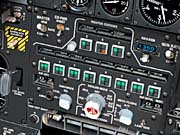
Yet the fact is that Lock On is built primarily to appeal to the schooled jet jock and those who have more than just a passing interest in airborne combat. Scalable? Definitely, but only to those who are willing to go well beyond arcade-style yank-and-crank flying games. And within these parameters, the game appears dressed for immediate success.
Lock On looks fantastic. We went into some detail about the game's graphics prowess in our previous coverage, so suffice it to say that with all visual options cranked all the way up, the game bears a surprising resemblance to real-life video footage. The cockpits are incredible works of 3D art, with functional and fully legible instruments and an authentically gritty and mechanical real-world feel. However, you can't directly control the cockpits' switches and buttons by toggling them with your mouse--you must use the various keyboard keys and key combinations to enact everything.
All camera perspectives--and there are dozens of them, along with a variety of modifiers--may be freely zoomed, unzoomed, or rotated. Unzooming is a great idea in the cockpit, where you can instantly gain a much wider field of vision. Zooming and mouse-looking through the cockpit is an even better idea, if just to grab an up close and personal look at all those beautifully modeled dials and controls. Camera adjustments are also recommended outside the cockpit, where you can better examine the nearby environment and more effectively take in the visuals.
Bring her down close to the water and get ready for the prettiest example of the liquid stuff ever seen in a flight game. Gain some altitude and immerse yourself in the game's incredibly lifelike depiction of clouds, contrails, and fog. Position yourself underneath your machine, launch a missile, and watch the underside reflect the glow. Take a gander just below the cockpit of the A-10 and note the little gizmo hanging there. That's a Pave Penny seeker system for detecting laser-marked targets, distinct to the Warthog and precious few other aircraft. These are the touches that will impress even the hardcore pilots.
Lock On's aircraft models are simply superb, sporting an extremely high level of detail and a full roster of animations and effects. The game's engine-heat blur effect is particularly impressive, as are the real-time shadows that follow you and your comrades on your journey. The damage modeling is also very good. Guns and cannons will rip realistic holes in your plane or perhaps tear off small bits. Missiles will cause larger holes or sometimes blow a wing or a tail section clear off. Impressively, separated sections don't always follow the natural joints of the aircraft. Much of the time, you'll find that missing parts have been torn away from the remaining fuselage, leaving a realistically ragged wound in its wake.
And certainly, damage is not confined to the skies. In our time with the game, we also blew up military installations, civilian structures, and commuter traffic, among other things. We even used the A-10's powerful cannon to topple a few electrical towers, sending them crashing to the ground in an impressively twisted mass of metal struts and cable. Sadly, our version didn't support ship damage, though Lock On producer Matt Wagner assures us that the retail edition will allow you to mutilate or sink virtually any boat.

The really good news is that Lock On should deliver a satisfactorily smooth frame rate on even a midlevel computer, without sacrificing too much of its extraordinary beauty. The game supports several resolutions, from 640x480 to 1280x960, and changing resolutions doesn't force you to quit and restart the game. Lock On also provides separate adjustments to nearly a dozen individual effects and events. If you find that certain effects such as explosions (which severely taxed the frame rate in our prerelease version), excess scenery, or haze cause graphics card or processor problems, you can simply remove or reduce them. Moreover, we found that the game looked quite satisfactory even at 800x600 with intermediate graphics effects.
Highway to the Danger Zone
Those who want to take their flying beyond quickie "instant action" sorties have numerous options at their disposal. Click the "open mission" button and you'll have access to dozens of canned operations. For true immersion, you'll want to opt for the mission editor, where all associated parameters can be defined. The mission editor's smartly designed interface allows you to choose opposing forces (13 countries are represented), painlessly drag and drop object types, switch between satellite and geophysics maps, zoom in and out, read your remarkably comprehensive textual briefings and debriefings, and much more, all via a minimum of screens and convenient overlays. The weather customization is particularly sophisticated, highly variable, and extremely realistic.
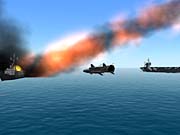
Lock On will offer two other modes of gameplay, arguably the most important of which is the campaign. Little detail is currently known about this mode, but this much is certain: It won't be dynamic. Ubisoft and Eagle have opted instead for the scripted variety, with tracked world damage between missions. Multiplayer Lock On will support LAN and Internet battles.
Of course, all the eye candy and perks in the world mean nothing if the artificial intelligence isn't up to snuff. And while we certainly can't give a verdict before we see the final product, this aspect of Lock On does look very promising. Enemy pilots seem to put up a good fight, definitely acting in accordance with the selected difficulty level and exhibiting incredible foresight and an impressive range of skills and tricks. In fact, if you choose ace mode, you'll want to watch them closely just to get ideas for your own arsenal--before they shoot you to pieces, that is.
Friendly pilots are a bit harder to gauge. At this stage, we found them to be a bit too intelligent, and perhaps a bit too talented. And their picture-perfect mirroring of our own flight pattern, mimicking every nuance and waggle, seemed a bit disconcerting. Ground-to-air installations, conversely, seem very pinned to the selected difficulty level. That's the way it should be, of course, but in ace mode, enemy radar detects you very quickly indeed, and the missiles and guns are frighteningly accurate. You'll definitely want to make use of the game's descriptive graphical encyclopedia in advance of your missions to examine closely what you'll be facing out there.
As for the physics modeling of the eight flyable aircraft, Eagle has done a wonderful job of creating distinguishable characteristics. Whether they're completely true to their real-life counterparts is a question that can only be answered by veteran pilots or folks who have a good working knowledge of each, but they certainly seem to adhere to believable parameters. Remember though, to really see what some of these aircraft can do, you'll have to jettison or fire off your weapons first to lighten the load.
The inclusion of the A-10 was a wise decision on a number of levels, not the least of which is its recent popularity. More importantly, it offers a refreshing break from the high-speed flourish of the other seven flyable aircraft. It's not a winged whale by any stretch of the imagination, even though its appearance may say otherwise. It's very maneuverable at low speeds and fortified with that merciless cannon and a variety of missiles and bombs, so it's easy to see why this distinctive beast has made such an impression.
Aircraft individuality is great, but Lock On also delivers the goods when it comes to flight model and avionics fidelity. Depending on your selected weapons and fuel loadout, the simulation will model seemingly accurate rates of acceleration, fuel consumption, and flight range. Accelerated stalls, speed bleeding in turns, air turbulence, and G-LOC blackout/redout effects are also present and--unless you switch them off at the options screen--are ready to negatively impact you just as easily as an enemy missile.
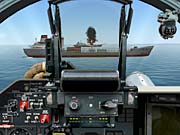
The sim's advanced avionics modeling is one of the biggest selling points for hardcore jet jocks. When full realism is toggled on, you'll need to expertly manipulate a variety of authentic knobs, switches, and screens--preferably via a good HOTAS joystick and throttle setup--in order to acquire your target, establish radar lock, and launch appropriate ordnance. Although some of these routines are common between aircraft, each plane boasts its own unique fire control and weapons delivery system that will demand extremely close study if you're serious about bringing your bird home in one piece.
A bold and elaborate game that seeks not only to resuscitate the air-combat genre but to spark the interest of rookie pilots and to combine the detail of a single-plane simulation with the versatility of a multi-aircraft game, Lock On: Modern Air Combat could turn out to be an exceptional game. We'll find out for sure when it touches down this November.
Got a news tip or want to contact us directly? Email news@gamespot.com
Join the conversation